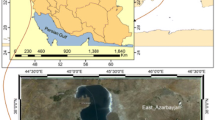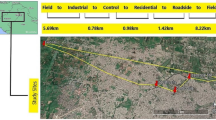Abstract
The present study deals with the characterization of effluent released from sponge iron industries and distribution of heavy metals in soil and macrophytes near to effluent discharge channel. Apart from this, accumulation of heavy metals in nearby soil and vegetation system irrigated with effluent-contaminated water is also the subject of this study. Physico-chemical analysis of effluent reveals that the concentration of total suspended solids (TSS), total hardness (TH), iron (Fe2+), and oil and grease are greater than the IS (1981) norms for discharge of water into inland water body. The soil along the sides of the effluent channel also shows higher concentration of heavy metals than the background soil. The enrichment of the heavy metals are in the order of Chromium (Cr) > Iron (Fe) > Manganese (Mn) > Zinc (Zn) > Copper (Cu) > Cadmium (Cd). Macrophytes growing along the sides of the effluent channel also show significant accumulation of heavy metals almost in the same order as accumulated in soil. Higher uptake of heavy metals by these varieties reveals that these species can be used for future phytoremediation. The effluent as well as contaminated water is extensively used for irrigation for growing vegetables like tomato (Lycopersicon esculatum) in the surrounding areas. Heavy metal accumulation in this agricultural soil are in the sequence of Cr > Fe > Mn > Zn > Cu > Cd. More or less similar type of accumulation pattern are also found in tomato plants except Fe and Zn exceeding Cr and Mn. Transfer Factor of heavy metals from soil to tomato plants (TFS) shows average value of <1, suggesting less uptake of heavy metals from soil. Among the plant parts studied, fruit shows least accumulation. Although tomato plants show some phenotypic changes, the survival of tomato plants as well as least accumulation of metals in fruit reveals their tolerance to heavy metals. Therefore it may be suggested that this plant can be grown successfully in the heavy metal contaminated soil. Further research work on in situ toxicity test will be necessary in order to identify the most resistive variety on this particular type of contaminated site.


Similar content being viewed by others
References
APHA (American Public Health Association) (1998) Standard Methods for the Examination of Water and Waste Water, 20th edn. APHA Washington
Atkinson BW, Bux F, Kasan HC (1998) Considerations for application of biosorption technology to remediate metal contaminated industrial effluents. Water SA 24:129–135
Barman SC, Lal MM (1994) Accumulation of heavy metals (Zn, Cu, Cd and Pb) in soils and cultivated vegetables and weeds grown in industrially polluted fields. J Environ Biol 15:107–115
Barman SC, Sahu RK, Bhargava SK, Chatterjee C (2000) Distribution of heavy metals in wheat, mustard, and weed grown in fields irrigated with industrial effluents. Bull Environ Contam Toxicol 64:489–496. doi:10.1007/s001280000030
Barman SC, Kisku GC, salve PR, Misra D, Sahu RK, Ramteke PW, Bhargava SK (2001) Assessment of industrial effluent and its impact on soil and plants. J Environ Biol 22:251–256
Beckett PHT, Davis RD (1977) Upper critical levels at toxic elements in plants. New Phytol 179:95–106
Boon DY, Soltanpour PN (1992) Lead, cadmium, and zinc contamination of aspen garden soils and vegetation. J Environ Qual 21:82–86
Bordin G, McCourt J, Rodriguez A (1992) Trace element in the marine bivalve Macoma balthica in the Westrschelde estuary. Sci Total Environ 127:225–280
Bowen HJM (1996) The biochemistry of the elements. In: Trace elements in biochemistry. Academic Press, London, pp 173–210
Brix H, Schierup HH (1989) The use of aquatic macrophytes in water pollution control. AMBIO 18:100–107
Cary EE, Allaway WH, Olson OE (1977) Control of chromium concentration in food plants, I and II. J Agric Food Chem 25:300–309
Chamberlain AC (1983) Fallout of lead and uptake by crops. J Atmos Environ 17:693–706
Espinoza-Quinones FR, Zacarkim CE, Palacio SM, Obreg´on CL, Zenatti DC, Galante RM, Rossi N, Rossi FL, Pereira IRA, Welter RA, Rizzutto MA (2005) Removal of heavy metal from polluted river water using aquatic macrophytes Salvinia sp. Brazilian J Phys 35:744–746
Fazeli M, Khosravan F, Hossini M, Sathyanarayan S, Satish PN (1998) Enrichment of heavy metal in paddy crops irrigated by papermill effluents near Najangud, Mysore District, Karnataka, India. Environ Geol 34:297–302
Fazeli MS, Sathyanarayan S, Satish PN, Mutanna L (1991) Effects of paper mill effluents on the accumulation of heavy metals in coconut trees near Najangud, Mysore District, Karnataka, India. Environ Geol Water Sci 17:47–50
Godson RE, Ana E, Sridhar MKC (2002) Soil quality near a chemical fertilizer industry at Port Harcourt, Nigeria. AJEAM/RAGEE 4(2):50–57
Harrison R, Chirgawi MB (1989) The assessment of air and soil as contributors of some trace metals to vegetable plants I. Use of a filtered air growth cabinet. Sci Total Environ 83:13–34
IS 2490 Part I (1981) Tolerance limits for industrial effluents discharged into inland surface waters: Part I—General limits. Bureau of Indian Standards
IS 11624 (1986) Guidelines for quality of irrigation water. Bureau of Indian Standards
Jarvis SC, Jones LHP, Hopper MJ (1976) Cadmium uptake from solution by plants and its transport from roots to stems. Plant Soil 44:179–191
Kaer C, Pederson MB, Elmegaard N (1998) Effects of soil copper on black bindweed (Fallopia convolvulus) in the laboratory and in the field. Arch Environ Contam Toxicol 35:14–20
Krishna AK, Govil PK (2005) Heavy metal distribution and contamination in soils of Thane-Belapur industrial development area, Mumbai, Western India. Environ Geol 47:1054–1061. doi:10.1007/s00254-005-1238-X
Mertz W (1969) Chromium occurrence and function in biological system. Physcol Rev 49:163–239
Mandaokar SS, Dharmadhikari DM, Dara SS (1994) Retrieval of heavy metal ions from solution via ferritisation. Environ Pollut 83:277–282
Miles LJ, Parker GR (1979) Heavy metal interaction for Andropogon scoparius and Rudbeckia hirta grown on soil from urban and rural sites with heavy metal additions. FJ Environ Qual 8:443–449
Nasu Y, Kugimoto M, Tanaka O, Takimoto A (1984) Lemna as an indicator of water pollution and the absorption of heavy metals by Lemna. In: Poscoe D, Edwards RW (eds) Freshwater biological monitoring. Pergamon Press, Oxford, pp 113–120
Nogueira F, Francisco De Assis Esteves, Prast AE (1996) Nitrogen and phosphorous concentration of different structures of aquatic macrophtes Eichornia azurea kunth and Scirpus cubensis Poepp & kunth in relation to water level variation in Logoa enfernao (Sao Paulo, Brazil). Hydrobiologia 328:199–205
Otte ML, Haarsma MS, Broekman RA, Rozema J (1993) Relation between heavy metal concentrations in salt marsh plants and soil. Environ Pollut 82:13–22
Rai UN, Sinha S, Tripathy RD, Chandra P (1995) Waste water treatability potential of some aquatic macrophytes: removal of heavy metals. Ecol Engre 5:5–12
Rao AV, Jain BL, Gupta IC (1993) Impact of textile industrial effluents on agricultural land—case study. Indian J Environ Health 35:132–138
Ray M, Barman SC, Khan S (1988) Heavy metal accumulation in rice plants: adaptation to environmental stress and consequent public health risks. In: Ozturk MA (eds) Plants and pollutants in developed and developing countries. Proc Inter Symp Izmir, Turkey, pp 421–441
Ray M, Barman SC (1988) Physiological responses of crop plants to waste effluents from i. steel and tar ii. Cycle and iii. Distillery industries: application of findings in measuring phytotoxicity. Indian Biol 20:16
Ray M, Saha R (1988) Effects of soil and water pollution on Brassica campestries caused by carbon black factory wastes. Indian Biol 20:23–29
Saha MK, Konar SK (1985) Impact of petroleum oil refinery effluent on Hooghly estuary ecosystem at Haldia, West Bengal. Environ Ecol 3(4):524–528
Singh KK, Mishra LC (1987) Effects of fertilizer factory effluent on soil and crop productivity. Water Air Soil Pollut 33:309–320
Sharma AM, Sharma YM (1997) Metallic pollution of soil sources, impact and management In: Cheremissinoff Paul N (ed) Ecological issues and environmental impact assessment. Gulf Publishing Company, Houston, pp 181–205
Shende A, Juvarkar AS, Daea SS (1993) Phytotoxic effects of heavy metals as influenced by soil properties. Pollut Res 12:75–83
Srivastava PK, Pandey GC (1999) Paper mill effluent induced toxicity in Eichornia crassipes and Spirodela Polyrrhiza. J Environ Biol 20(4):317–320
Wainweright SJ, Woolhouse HW (1977) Some physiological aspects of Cu and Zn tolerance in Agrostis tenuis Sibth…Cell elongation and membrane damage. J Exp Bot 28:1029–1036
Wolverton BC (1987) Aquatic plants for fresh water treatment: An overview In: Reddy KR, Smith WH (eds) Aquatic plants for water treatment and resource recovery. Magnolia Publications, Orlando, pp 3–16
Xian X, Shokohifard G (1989) Effect of pH on chemical forms and plant availability of cadmium, zinc and lead in polluted soils. Water Air Soil Pollut 45:265–273
Acknowledgments
The authors gratefully acknowledge Prof J. K. Datta and Dr A. R. Ghosh, of The Department of Environmental Science, The University of Burdwan, for their crucial evaluation and suggestions, which greatly helped to improve the manuscript. Sincere thanks and appreciation are also due to all the editors and reviewers of this manuscript.
Author information
Authors and Affiliations
Corresponding author
Rights and permissions
About this article
Cite this article
Gupta, S., Nayek, S., Saha, R.N. et al. Assessment of heavy metal accumulation in macrophyte, agricultural soil, and crop plants adjacent to discharge zone of sponge iron factory. Environ Geol 55, 731–739 (2008). https://doi.org/10.1007/s00254-007-1025-y
Received:
Accepted:
Published:
Issue Date:
DOI: https://doi.org/10.1007/s00254-007-1025-y




